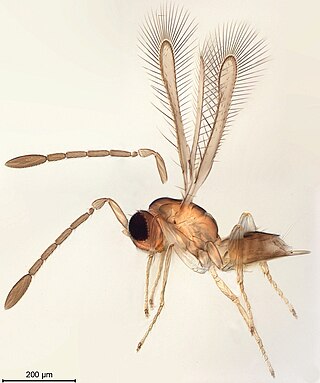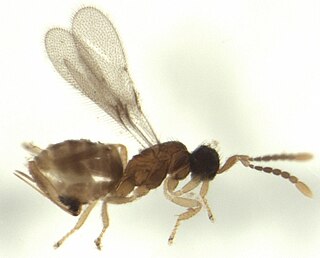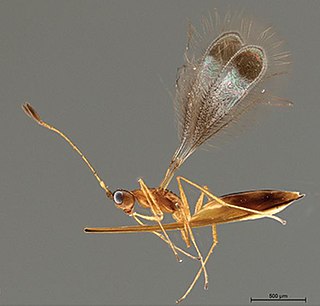Related Research Articles

The Mymaridae, commonly known as fairyflies or fairy wasps, are a family of chalcidoid wasps found in temperate, subtropical, and tropical regions throughout the world. The family contains around 100 genera with 1,400 species.

The Baeomorphidae, are a very small family of rare, relictual parasitic wasps in the superfamily Chalcidoidea, known primarily from fossils. Only two extant species are known, each in its own genus, one from New Zealand and one from Chile, and little is known about their biology, though there is suspicion that they are parasitoids of the relictual true bug family Peloridiidae.

Kikiki is a genus of fairyfly wasps containing a single species, Kikiki huna, known from Hawaii, Costa Rica, Nagarcoil and Trinidad. At 0.15 mm (0.0059 in), it is the smallest flying insect known as of 2019. It is a close relative of wasps in the genus Tinkerbella. It was discovered in the Hawaiian Islands by John T. Huber and John W. Beardsley, and published in 2000. The name Kikiki huna consists of two Hawaiian words that both carry the meaning 'tiny bit'.

Arescon is a genus of fairyflies. It contains the following species:

Tytthodiplatys is an extinct genus of earwig in the family Diplatyidae known from a Cretaceous fossil found in Myanmar. The genus contains a single described species, Tytthodiplatys mecynocercus.

Tinkerbella is a genus of fairy wasps, containing the single species Tinkerbella nana from Costa Rica. It is one of the smallest known flying arthropods and belongs to the family Mymaridae.

Acmotemnus is a genus of fairyflies in the family Mymaridae. This genus has a single species, Acmotemnus luteiclava, found in New Zealand.

Dicopomorpha is a wasp genus in the family Mymaridae.
Rotoita basalis is a small parasitic wasp in the relictual family Baeomorphidae. It is known only from New Zealand, and its closest known living relative is endemic to Chile.
Zigrasolabis is an extinct genus of earwig in the family Labiduridae known from Cretaceous fossils found in Myanmar. The genus contains a single described species, Zigrasolabis speciosa.
Toxolabis is an extinct genus of earwig in the dermapteran family Anisolabididae known from a Cretaceous fossil found in Burma. The genus contains a single described species, Toxolabis zigrasi.
Anaphes nitens is a species of fairyfly, a chalcid wasp in the family Mymaridae. Native to Australia, it is an egg parasitoid of the gum tree snout beetle, a pest of Eucalyptus trees, and has been used in biological pest control of that species.

Anagrus is a genus of fairyflies, in the family Mymaridae, comprising over 90 species, a number of which are employed as biocontrol agents. They come in a wide array of colors such as, brown, orange, black and pale. For classificatory purposes, the genus is divided into three subgenera Anagrella, Anagrus and Paranagrus. The adults lay eggs on the host, mainly Hemiptera, with a few using Odonata as hosts.

Polynema is a genus of fairyflies or fairy wasps, insects in the family Mymaridae.
This list of fossil arthropods described in 2011 is a list of new taxa of trilobites, fossil insects, crustaceans, arachnids and other fossil arthropods of every kind that have been described during the year 2011. The list only includes taxa at the level of genus or species.

Mymar is a genus of fairyflies in the family Mymaridae. There are about 10 described species in Mymar.
References
- ↑ Sankararaman, H.; Manickavasagam, S.; Palanivel, S. (2019). "Description of a new species of Dicopus Enock and first report of Platystethynium glabrum Jin & Li (Hymenoptera: Mymaridae) from India". Oriental Insects. 54 (4): 1–13. doi:10.1080/00305316.2019.1691670.
- ↑ Anwar PT; Zeya SB (2018). "The genus Dicopus Enock (Hymenoptera: Chalcidoidea: Mymaridae)in India with description of two new species". Journal of Asia-Pacific Entomology. 21 (2): 682–687. Bibcode:2018JAsPE..21..682A. doi:10.1016/j.aspen.2018.03.012.